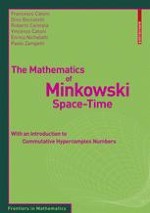2008 | Buch
The Mathematics of Minkowski Space-Time
With an Introduction to Commutative Hypercomplex Numbers
verfasst von: Francesco Catoni, Dino Boccaletti, Roberto Cannata, Vincenzo Catoni, Enrico Nichelatti, Paolo Zampetti
Verlag: Birkhäuser Basel
Buchreihe : Frontiers in Mathematics
